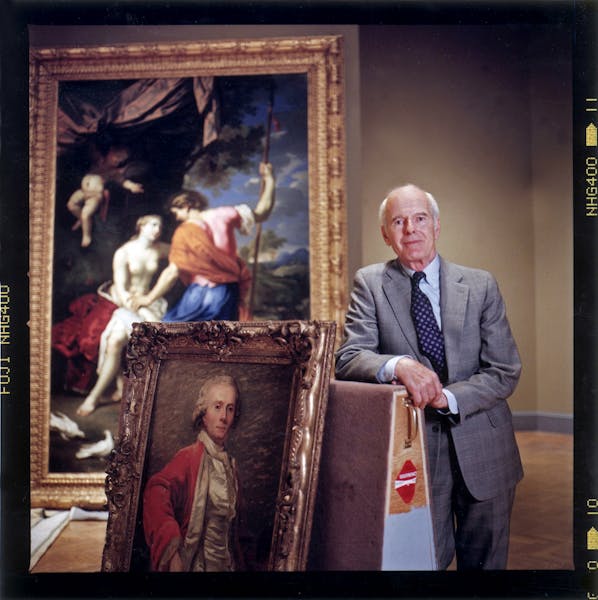Wherever he went in the world, Bruce Dayton always had the Minneapolis Institute of Art on his mind and in his heart.
He was just 24 and not long out of college when he was elected to its board of directors in 1942. By the time he died Friday he was the museum's longest-serving trustee and the most generous in its history. In his 73 years of engagement, the former CEO of what is now Target Corp. gave the museum more than $80 million in cash, and helped launch endowments that now total $27.5 million.
Although a tweedy businessman by profession, Dayton was an aesthete by temperament. He worked closely with curators but also followed his own well-educated eye and instincts when buying for the institute. Over the years he gave the Minneapolis museum more than 2,000 works of art in virtually every field, from a Shoshone painted elk hide that is a cornerstone of the American Indian galleries, to an iconic Monet painting of a pink grainstack glowing in a sunset meadow, to 14 galleries of ancient Chinese furniture, paintings and sculpture.
Art dealers around the world knew and admired Dayton and his wife, Ruth Stricker Dayton, who sparked his interest in Chinese art and culture in the early 1990s. In the glitzy world of high-end art where many collectors flash their money, Dayton was an auction-floor poker player who bid with a nod or the flick of a finger, never more.
He and his wife were known for their expertise and discretion. Working with Robert Jacobsen, then the museum's curator of Asian art, the Daytons set about building a world-class collection for Minneapolis at a time when China was just reopening to the world and top-quality pieces were available for the first time in decades.
James Lally, a New York dealer in Chinese art, in 2002 called them "without doubt the greatest patrons of Chinese art in America in the past decade or more, and they've done it with such grace and style that they are universally admired — and uniquely well liked — by curators, collectors and dealers alike."
By then, they had spent more than $20 million on Chinese art, including Ming dynasty furniture, 4,000-year-old ceramics, 17th-century portraits, calligraphy and more. They imported an entire Ming reception hall and a 1797 scholar's study that was being used for farm storage in a remote village. In 1996 they set a world auction record for Chinese furniture when they paid $1.1 million for a carved-wood and marble screen.
He remembered everything and seemed to love every piece, however grand or comparatively humble. I once mentioned to him that one of my favorite pieces in the museum's collection was a little palm-sized tea bowl that has the ghost of a leaf burned into its brown glaze. Ah, yes, he said — leaf bowls are among the rarest Chinese ceramics. That one was made in the Sung dynasty (960-1279), he recalled, adding that he'd paid $35,000 for it in 1998.
During his decades as a business executive, Dayton often celebrated corporate milestones with a gift to the museum. After Dayton Corp. went public in 1967, he gave the museum "The Smoker," an 1866 masterpiece by Édouard Manet that is a centerpiece of the 19th-century galleries.
French art was Dayton's first love, and his gifts range from popular crowd-pleasers like the Monet grainstack to grand subjects like "Venus and Adonis," an allegorical love scene from 1650 by Nicolas Mignard, court painter to King Louis XIV, and intimate artist-designed books by Matisse and Picasso.
Unlike many collectors, he typically bought art and gave it directly to the museum rather than keeping it at home for years before bequeathing it. Still, he hung rare and beautiful pieces in unexpected places, like an exquisite drawing of a chrysanthemum by Piet Mondrian that once graced the entrance powder room of his Wayzata home.
A delicate line drawing, "Chrysanthemum" is very unlike the geometric abstractions for which Mondrian is most famous. Instead, it's the kind of keenly observed drawing-from-nature that spoke to the connoisseur's eye of Dayton. He later gave it to the museum, along with one of Mondrian's classic abstractions.
His eclectic tastes and generosity were known throughout the art world. Besides the institute, Dayton and his wife contributed significantly to the recent capital campaigns of Walker Art Center, the Minneapolis Public Library, the Guthrie Theater, and especially the art gallery of Yale University, his alma mater, where the Asian galleries were renamed in their honor. They sponsored shows at the China Institute in New York and provided major financial support to the Shanghai Museum of Art.
But his reputation extended far outside such marquee sites. About 25 years ago, I spied in a Paris gallery a little drawing of a nude girl slumbering on a sofa. Recognizing it as a study for the institute's famous painting by the French artist Gustave Caillebotte, I asked if the gallery had contacted the museum about the drawing.
Yes, but they had no ready funds.
Perhaps, if you had reached the museum's great benefactor, I began.
"Ah, yes, we wrote to Mr. Dayton, too," the gallery owner replied before I even murmured the name, "but he had other commitments."
Mary Abbe • 612-673-4431
